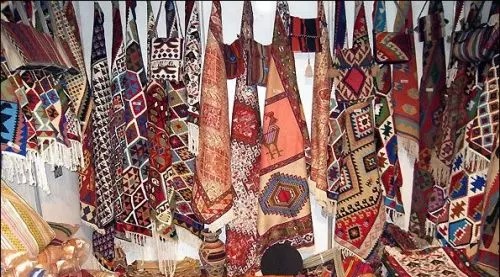Sari Handicrafts and Souvenirs
Sari’s handicrafts and souvenirs are one of the most captivating aspects of Mazandaran’s culture, attracting both domestic and international tourists with their variety and richness. Crafted using local materials and traditional techniques, these unique and high-quality products stand out. Notable handicrafts include carpet weaving, kilim weaving, jajim knitting, and reed weaving, each showcasing the unparalleled artistry and skills of local artists. Sari’s handicrafts are recognized not only as souvenirs but also as part of the city’s cultural heritage, passed down through generations, each telling a story of local history and culture.
Sari’s souvenirs, with an assortment of local foods such as olives, citrus fruits, pickles, and special sweets, have captured the hearts of visitors. These culinary delights with their authentic and natural flavors serve as mementos and are part of the travel experience to Sari. Additionally, wooden products like lacquerwork and pottery, crafted with precision and artistry, are among the beloved souvenirs that can enhance your home and bring lasting memories of your trip to Sari.
Iran Charter Company offers reliable and comfortable travel services to help you choose the best routes and accommodations for visiting Sari’s handicrafts and souvenirs. With our services, you can enjoy a unique travel experience filled with beautiful memories in Sari city. Sari’s handicrafts and souvenirs are significant not only economically but also culturally for the locals, playing a vital role in preserving and promoting local culture and traditions. Therefore, visiting Sari and purchasing these handicrafts and souvenirs not only allows you to enjoy the natural and cultural beauties of the area but also supports the local economy and helps preserve cultural heritage.
History and Significance of Handicrafts and Souvenirs in Sari
The handicrafts and souvenirs of Sari, as prominent parts of the cultural heritage of Mazandaran, are deeply rooted in the history of this region. Sari, with its ancient history and rich culture, has always been a place where craftsmanship and art have thrived. Since ancient times, the people of Sari have used local raw materials and traditional techniques to create unique products that not only possess visual beauty but also convey cultural stories and values. These handicrafts include carpet weaving, kilim weaving, jajim weaving, basket weaving, and pottery, each showcasing the unparalleled skills and creativity of local artisans. The importance of these handicrafts goes beyond their beauty; these products are symbols of the region’s identity and history, passed down through generations, playing a crucial role in preserving and promoting local culture. Additionally, Sari’s souvenirs, such as local delicacies and wooden products, with their high quality and unique variety, hold a special place in the hearts of local and foreign tourists. These souvenirs are not just mementos of a trip to Sari but also a part of the city’s cultural and economic experience.
The Most Diverse Types of Sari Carpets
Carpet weaving in Sari is one of the oldest and most reputable handicrafts in the area, holding a unique position in both local and international markets due to its high variety of designs and colors. Sari carpets, made from high-quality yarns and natural raw materials, each tell a unique story. Traditional designs, including flowers, human faces, and geometric patterns, are woven with great precision and artistry. In recent years, modern designs have been added to Sari carpets, gaining more traction in young markets. The unique weaving techniques and the use of authentic colors make these carpets a desirable choice for interior decoration. Their high quality and durability make them an ideal option for buyers seeking beautiful and valuable items. Renowned stores and workshops in Sari offer a variety of these carpets, catering to different consumer tastes.
Jajim Weaving: The Traditional Art of Sari
Jajim weaving is another standout handicraft of Sari, holding a special place in the world of handicrafts with its rich history and specific techniques. Jajims, made using natural wool and precise weaving, depict various patterns and designs that reflect the artisan’s taste and creativity. Beyond their beauty, these handicrafts also have practical uses and are employed as rugs, cushions, and even interior decorations in homes. Jajim weaving in Sari utilizes natural colors and traditional patterns, each reflecting local stories and culture. In addition to traditional products, local artists are also adopting modern and innovative designs, expanding the market for this craft to younger generations and international audiences. Their high quality and durability make them an ideal choice for buyers looking for authentic and valuable artworks.
Basket Weaving: Traditional and Practical in Sari
Basket weaving is one of Sari’s indigenous handicrafts, creating unique products using local plants and traditional techniques. Sari baskets, durable and resilient, are used in local homes as baskets, bags, and mats and also serve as popular souvenirs for tourists. These products, crafted using natural plant fibers, are not only strong but also lightweight, making them easy to transport. Handmade techniques in basket weaving turn each piece into a work of art, symbolizing the skill and creativity of local artisans. Simple and beautiful designs, complemented by natural colors, enhance the beauty and functionality of these products. Some baskets are adorned with more complex designs and diverse colors, making them suitable for home interior decoration and cultural and religious uses. Handcrafted workshops and stores in Sari offer a wide variety of these baskets with high quality, making them an ideal choice for esteemed buyers.
Pottery and Ceramics in Sari
Pottery and ceramics in Sari, using the region’s virgin clay, produce high-quality artistic and practical products. This handicraft, which has long been prevalent in the region, utilizes both traditional and modern techniques to produce various pottery dishes, bowls, mugs, and traditional decorations that sell well in both domestic and international markets. Sari pottery, with its beautiful designs and detailed finishes, is used not only in daily consumption but also in interior decoration. The use of natural colors and sustainable methods in production assures the quality and durability of these products. Besides producing dishes, Sari artisans also create artworks such as small statues and ceramic paintings that reflect the region’s culture and nature. Visiting pottery workshops in Sari offers a great opportunity to observe the production process and purchase these authentic and high-quality products directly. These items, offered at reasonable prices and high quality, are an excellent option for esteemed buyers seeking genuine and unique artworks.
Lak Trapping: The Wooden Art of Sari
Lak trapping in Sari, using local wood and precise techniques, creates artistic and functional wooden products that have been well-received in both local and international markets. This handicraft, passed down from past generations to the present, embodies a blend of tradition and art. Lak traps from Sari include wooden utensils like mugs, bowls, sugar containers, and kitchenware, decorated with beautiful designs and detailed finishes. Lak craftsmen produce durable and beautiful products using natural colors and sustainable techniques, which are useful not only in daily life but also in home decoration. Due to their high quality and unique designs, Sari’s lak traps hold a special place among handicraft products and are recommended as popular souvenirs for tourists. Some lak trap products, using more creative techniques and modern designs, become works of art that add a beautiful touch to any home. A visit to lak trap workshops in Sari offers a great opportunity to observe the production process and purchase these high-quality and authentic products directly.
Culinary Souvenirs: The Authentic Taste of Sari
Sari’s culinary souvenirs, made using natural raw materials and traditional methods, offer tourists a variety of delicious and quality products that are not just mementos but part of the valuable travel experience to this city. Some of the most famous culinary souvenirs of Sari include fresh citrus fruits, local jams, olives, a variety of pickles, and special sweets. Sari’s citrus fruits, especially oranges and lemons, with their sweet and natural flavors, are an ideal choice for souvenirs. Orange peel jams and garlic pickles, pomegranate pickles are other popular products of the city that, with high quality and unique flavors, hold a special place among culinary souvenirs. Additionally, pure olive oil from Sari, with its original flavors and high quality, is considered one of the city’s economically profitable products. Traditional sweets such as pistachios and coins are among other popular culinary souvenirs produced with natural ingredients and without harmful additives. Purchasing these souvenirs from local markets and reputable stores in Sari not only allows you to enjoy authentic and natural flavors but also supports the local economy and preserves the region’s culinary traditions.
The Role of Handicrafts and Souvenirs in the Local Economy
Handicrafts and souvenirs play a very important role in the local economy of Sari. Considering that handicrafts, including carpet weaving, kilim weaving, jajim weaving, basket weaving, and lak trapping, are among the most important income sources for the people of Sari, these crafts not only help provide livelihoods for families but also attract tourists and increase foreign exchange revenues. The sale of handicrafts in domestic markets and their export to various countries has created opportunities for the development of small and medium-sized enterprises. In addition, handicrafts add value to their products by preserving and promoting traditional culture and art, which increases the attraction of foreign and domestic customers. Furthermore, these crafts help improve the social and economic status of the region by creating employment and enhancing technical and artistic skills among young people. Supporting handicraft producers and creating suitable infrastructure for the sale and marketing of these products can lead to increased local revenues and sustainable economic development. As a result, handicrafts and souvenirs in Sari are recognized not only as products with cultural value but also as the main pillars of the local economy, playing an important role in the advancement and development of the region.
Reliable Places to Buy Handicrafts and Souvenirs in Sari
To buy handicrafts and souvenirs in Sari, it is essential to visit reputable and well-known places in the city to obtain high-quality and authentic products. Local markets in Sari, such as traditional bazaars and reputable stores, are the best options for purchasing handicrafts and souvenirs. In these markets, you can find various carpets, kilims, jajims, baskets, and other handmade products at reasonable prices and high quality. Additionally, visiting handicraft production workshops offers an excellent opportunity to observe the production process and purchase directly from producers, which can help reduce purchase costs and increase the chance of choosing desired products. Museums and art galleries are also suitable places to learn more about the history and art of Sari’s handicrafts, and you can see diverse examples of these crafts there. Moreover, tours organized by reputable companies like (Iran Charter) can include visits to handicraft production sites and well-known stores, providing tourists with easy access to these products. Buying from reputable online stores is also another option for purchasing Sari souvenirs, which is especially suitable for those who cannot make in-person visits. By choosing reputable and credible places to buy, you can ensure the quality and authenticity of handicraft products and Sari souvenirs.
Education and Promotion of Handicrafts in Sari by Iran Charter
(Iran Charter), as one of the pioneers in the field of tourism and local gift industry, plays an important role in the education and promotion of Sari handicrafts. This company, by organizing specialized tours and providing comprehensive services, helps local artisans and producers introduce their products to wider markets. Among (Iran Charter)’s actions are providing a platform for showcasing and selling handmade products at reputable events and exhibitions, organizing training workshops to increase skills and improve production quality, and creating international collaborations for exporting handicraft products. Additionally, (Iran Charter) facilitates the sale of handmade products for local artisans by using online platforms and social networks, helping them reach a wider audience. These actions not only promote local culture and art but also lead to job creation and increased income for artisans and producers. (Iran Charter), focusing on the quality and authenticity of Sari handicraft products, strives to create continuous and effective communication between producers and customers to aid in the sustainable growth and development of this industry. Therefore, collaboration with (Iran Charter) for Sari handicraft artisans and producers can provide new opportunities for developing small and medium-sized enterprises.
The Impact of Tourism on Handicrafts and Souvenirs in Sari
Tourism has a significant impact on the prosperity and development of handicrafts and souvenirs in Sari. With the increase in domestic and foreign tourists searching for Sari and Mazandaran, the demand for artistic products and local souvenirs also rises. By purchasing Sari’s handicrafts and souvenirs, tourists not only support the local economy but also contribute to spreading the region’s traditional culture and art. Increased tourism leads to improved security, transportation, and service infrastructures, which in turn can facilitate the production and sale of handicrafts. Additionally, cultural tourism provides artisans and producers the opportunity to improve their products with direct feedback from customers and create new innovations in design and production. Specialized tourism tours focusing on visiting handicraft workshops and stores can offer a unique and educational experience for tourists and create a closer connection between producers and buyers. This connection not only helps increase sales but also aids in preserving and transferring traditional knowledge and skills to future generations. Ultimately, tourism can assist the handicraft and souvenir industry in Sari to achieve sustainable development and increase foreign exchange earnings by leveraging new opportunities.
Guide to Choosing and Buying Handicrafts and Souvenirs in Sari
Choosing and buying handicrafts and souvenirs in Sari requires care and attention to detail to ensure the purchase of a quality and authentic product. The first step in this process is knowing the different types of handicrafts and souvenirs available in Sari. Precise knowledge of the product type, used raw materials, and weaving or carving techniques can aid in making a better choice. For example, in selecting Sari carpets, attention should be paid to the type of yarn, design, and quality of the weave. Additionally, checking the seal and the artist’s name can indicate the product’s authenticity and quality. Purchasing from reputable stores and direct production workshops from local artisans is recommended to ensure the quality and authenticity of the products. Moreover, comparing prices and reviewing previous customer opinions can aid in better decision-making when purchasing. In some cases, weaving and carving products can take longer, so proper planning for pre-purchase can prevent potential issues. Additionally, proper maintenance and care of handicrafts after purchase are important to enjoy the beauty and durability of products for a long time. Guidance provided by reputable companies like (Iran Charter) can also be helpful in the process of choosing and buying handmade and souvenir products from Sari, as these companies offer precise information and expert advice to help buyers make informed and confident choices.
Challenges and Solutions for Developing Handicrafts and Souvenirs in Sari
Developing handicrafts and souvenirs in Sari faces various challenges that require effective solutions to overcome. One of the main challenges is preserving authenticity and passing traditional techniques to new generations. With increasing trends towards modern products and changing lifestyles, it is necessary to preserve and enhance traditional weaving and carving skills through training and educating young people. In addition, competition with imported products and declining demand for local products are other fundamental challenges. To address these issues, effective advertising and enhancing the product branding of Sari can help increase recognition and demand. Creating extensive distribution networks and using online platforms can also facilitate access to new markets and increase sales. Supporting artists and handicraft producers with financial aid and government facilities can provide a strong incentive for continuing activity and developing these industries. Moreover, encouraging innovation and combining traditional techniques with modern designs can help attract new audiences and increase product sales. Collaborating with reputable tourism companies like (Iran Charter) can provide new opportunities for showcasing and selling handicrafts. Ultimately, creating a suitable environment for interaction and close connection between producers and buyers can build trust and increase customer satisfaction, in turn helping the sustainable development of Sari’s handicrafts and souvenirs.
The Role of Education and Skill Development in Handicrafts and Souvenirs in Sari
Education and skill development are key factors in enhancing the quality and efficiency of Sari’s handicrafts and souvenirs. Given that the region’s handicrafts are based on traditional techniques, transferring this knowledge to new generations is of special importance. Holding training courses and specialized workshops in various fields of handicrafts can help increase the skills of local artists and producers. This education can include training in weaving techniques, carving, painting, and designing, which improves product quality and increases their diversity. Additionally, developing marketing skills and online sales is also essential for artists to offer their products to broader markets and take advantage of new opportunities. Collaborating with universities and educational institutions to create educational programs and exchange knowledge can enhance the level of production and innovation in Sari’s handicrafts. Using new technology in production and marketing can also facilitate processes and increase access to new markets. Moreover, creating local art communities and groups where artists can share their experiences and knowledge can strengthen collaboration networks and enhance technology levels in handicraft production. The role of government and supportive institutions in providing financial facilities and creating suitable infrastructure for education and skill development is also very vital. Ultimately, focusing on education and skill development can help maintain and enhance the traditional arts of Sari and increase the competitiveness of products in domestic and foreign markets, contributing to the sustainable development of Sari’s handicrafts and souvenirs.
The Impact of Modern Technologies on Handicrafts and Souvenirs in Sari
The impact of modern technologies on handicrafts and souvenirs in Sari is a vital and abundant issue that plays a significant role in enhancing quality, increasing efficiency, and expanding markets for this industry. Using modern tools in handicraft production can make weaving, carving, and painting processes faster and more precise without harming the traditional authenticity and beauty of the products. For example, using advanced weaving machines can help increase production and reduce carpet and kilim production time. Additionally, digital design and modeling software can assist artists in creating more complex designs with ease and precision, quickly integrating these designs into their products. Communication technologies like the Internet and social networks also enable access to more extensive markets for handicraft producers. By creating online stores and using e-commerce platforms, artists can offer their products directly to domestic and international customers, thereby increasing their sales. Furthermore, using digital marketing tools like online advertising and search engine optimization (SEO) can help increase brand recognition and attract new customers. Moreover, technologies related to supply chain management can improve production, packaging, and distribution processes and ensure the accuracy and security of products. Ultimately, combining modern technologies with traditional techniques can lead to unique and high-quality products with more competitiveness in global markets. However, it is essential for Sari’s handicraft artists and producers to carefully use modern technologies to maintain a balance between preserving authenticity and improving quality.
Frequently Asked Questions
- What are the famous handicrafts of Sari?
- Famous handicrafts of Sari include carpets, kilims, jajimche, chuga, basket weaving, lacquer traps, and wave weaving.
- Where are the best places to buy souvenirs in Sari?
- The daily markets of Sari and specialized handicrafts centers are among the best places to buy souvenirs and handicrafts in the city.
- What are the characteristics of Sari city?
- Sari is a city with a rich history, diverse culture, and numerous handicrafts, making it one of the most important historical and tourist cities in Mazandaran.
- What is wave weaving in Sari and how is it done?
- Wave weaving is an art made from wool and woven into colorful bedspreads. This handicraft is affordable and durable, often seen in the local markets of Sari.
- How is pottery and ceramics made in Sari?
- Pottery and ceramics are ancient handicrafts in Sari, using suitable clay in the area to produce beautiful ceramic pots and dishes. Many pottery centers offer public tours.
- What are the applications of felt making in Sari?
- Felt making in Sari is used for producing various baskets, hats, bags, and mats. This craft is made with wool and results in durable and beautiful products.
- How is lacquer trapping done in Sari handicrafts?
- Lacquer trapping in Sari is done using the wood of trees like maple and beech without tools. Master craftsmen design and build various wooden utensils such as sugar bowls and ladles.
- What types of wooden utensils are available in Sari?
- Wooden utensils in Sari include jouleh, lac-daneh dispensers, spoons, ladles, and other kitchen tools, crafted with inlay and marquetry.
- What is the difference between charter and regular flight tickets?
- Charter tickets are for specific flights on set dates, while regular tickets are for routine and daily flights.
- How can I book a flight ticket from Iran Charter?
- To book a flight ticket from Iran Charter, visit the Iran Charter website and use the online reservation system to select and purchase your desired ticket.
- What are the important points after buying a flight ticket?
- After purchasing a flight ticket, ensure all entered information is correct, check flight schedules, and prepare your passport and visa for international trips.
- Please explain how to return to the homepage.
- To return to the homepage, click on the Iran Charter website logo or use the main website menu.
- How can I contact Iran Charter?
- You can contact us via phone numbers 02191091190, 09104951009, 09129369660, or email info@irancharter.ir.
- What are the benefits of using Iran Charter services?
- Benefits of using Iran Charter services include easy and quick ticket booking, 24-hour support, best prices offered, and secure ticket purchases.
- Does Iran Charter offer last-minute ticket purchase opportunities?
- Yes, Iran Charter offers last-minute ticket purchase opportunities, allowing you to secure final tickets at a reasonable price if needed.
- How do I install the Iran Charter app on my smartphone?
- To install the Iran Charter app, follow the installation guide on our website, which includes downloading from online stores and adding to your smartphone’s home screen.












